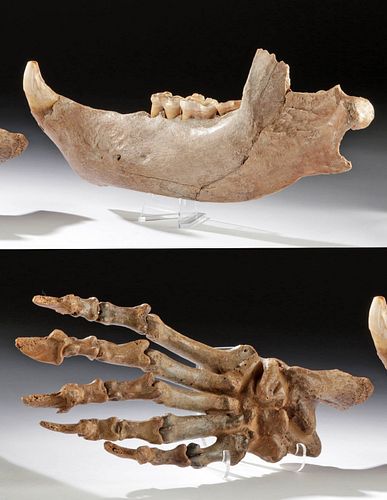Fossilized Pleistocene Cave Bear Foot + Mandible
Lot 98
About Seller
Artemis Fine Arts
686 S Taylor Ave, Ste 106
Louisville, CO 80027
United States
Selling antiquities, ancient and ethnographic art online since 1993, Artemis Gallery specializes in Classical Antiquities (Egyptian, Greek, Roman, Near Eastern), Asian, Pre-Columbian, African / Tribal / Oceanographic art. Our extensive inventory includes pottery, stone, metal, wood, glass and textil...Read more
Categories
Estimate:
$2,000 - $3,000
Absentee vs Live bid
Two ways to bid:
- Leave a max absentee bid and the platform will bid on your behalf up to your maximum bid during the live auction.
- Bid live during the auction and your bids will be submitted real-time to the auctioneer.
Bid Increments
| Price | Bid Increment |
|---|---|
| $0 | $25 |
| $300 | $50 |
| $1,000 | $100 |
| $2,000 | $250 |
| $5,000 | $500 |
| $10,000 | $1,000 |
| $20,000 | $2,500 |
| $50,000 | $5,000 |
| $100,000 | $10,000 |
| $200,000 | $20,000 |
About Auction
By Artemis Fine Arts
Aug 27, 2020
Set Reminder
2020-08-27 10:00:00
2020-08-27 10:00:00
America/New_York
Bidsquare
Bidsquare : VARIETY SALE | Antiquities & Ethnographic Art
https://www.bidsquare.com/auctions/artemis-gallery/variety-sale-antiquities-ethnographic-art-5477
Around the world & back in time - be amazed at the treasures you will find. Antiquities from Egypt, Greece, Italy and the Near East, Asian, Pre-Columbian, African / Tribal / Oceanic, Native American, Spanish Colonial, Russian Icons, Fine Art, much more! Artemis Fine Arts info@artemisfinearts.com
Around the world & back in time - be amazed at the treasures you will find. Antiquities from Egypt, Greece, Italy and the Near East, Asian, Pre-Columbian, African / Tribal / Oceanic, Native American, Spanish Colonial, Russian Icons, Fine Art, much more! Artemis Fine Arts info@artemisfinearts.com
- Lot Description
Ancient Europe, Pleistocene epoch, ca. 1.2 million to 24,000 years ago. A massive fossilized foot of a European cave bear (Ursus spelaeus), with its almost humanlike form and long claws, and a fossilized mandible from the same species with its teeth intact. Wear on the teeth indicates that this was a fully grown adult individual. Enormous cave bears were first described in 1774, and scientists at the time thought their huge remains might be polar bears. Later scientists realized that they were once part of the group of megafauna that roamed Ice Age Europe - alongside mammoths, wooly rhinos, giant deer, and lions - and males of the species could be fifty percent larger than modern day grizzly bears. Ancient humans were aware of the animals and painted them on the walls of caves. Despite their fierce appearance, cave bears had a mostly vegetarian diet, and ultimately went extinct during the Last Glacial Maximum ca. 27000 to 24000 years ago, when the vegetation they relied upon disappeared. Size of mandible: 11" W x 4.25" H (27.9 cm x 10.8 cm)
Provenance: private Glorieta, New Mexico, USA collection, acquired several years ago; ex-private Tucson, Arizona, USA collection
All items legal to buy/sell under U.S. Statute covering cultural patrimony Code 2600, CHAPTER 14, and are guaranteed to be as described or your money back.
A Certificate of Authenticity will accompany all winning bids.
We ship worldwide and handle all shipping in-house for your convenience.
#149357The foot has been repaired above the wrist and the joints are held in place with wires; these wires are not visible. Mandible has been repaired from three pieces and has a weathered surface and some losses from the peripheries, but overall really nice preservation with the teeth in great condition.Condition
- Shipping Info
-
All shipping is handled in-house for your convenience. Your invoice from Artemis Gallery will include shipping calculation instructions. If in doubt, please inquire BEFORE bidding for estimated shipping costs for individual items.
-
- Buyer's Premium



 EUR
EUR CAD
CAD AUD
AUD GBP
GBP MXN
MXN HKD
HKD CNY
CNY MYR
MYR SEK
SEK SGD
SGD CHF
CHF THB
THB














